1996 CHEVROLET TAHOE heating
[x] Cancel search: heatingPage 69 of 403
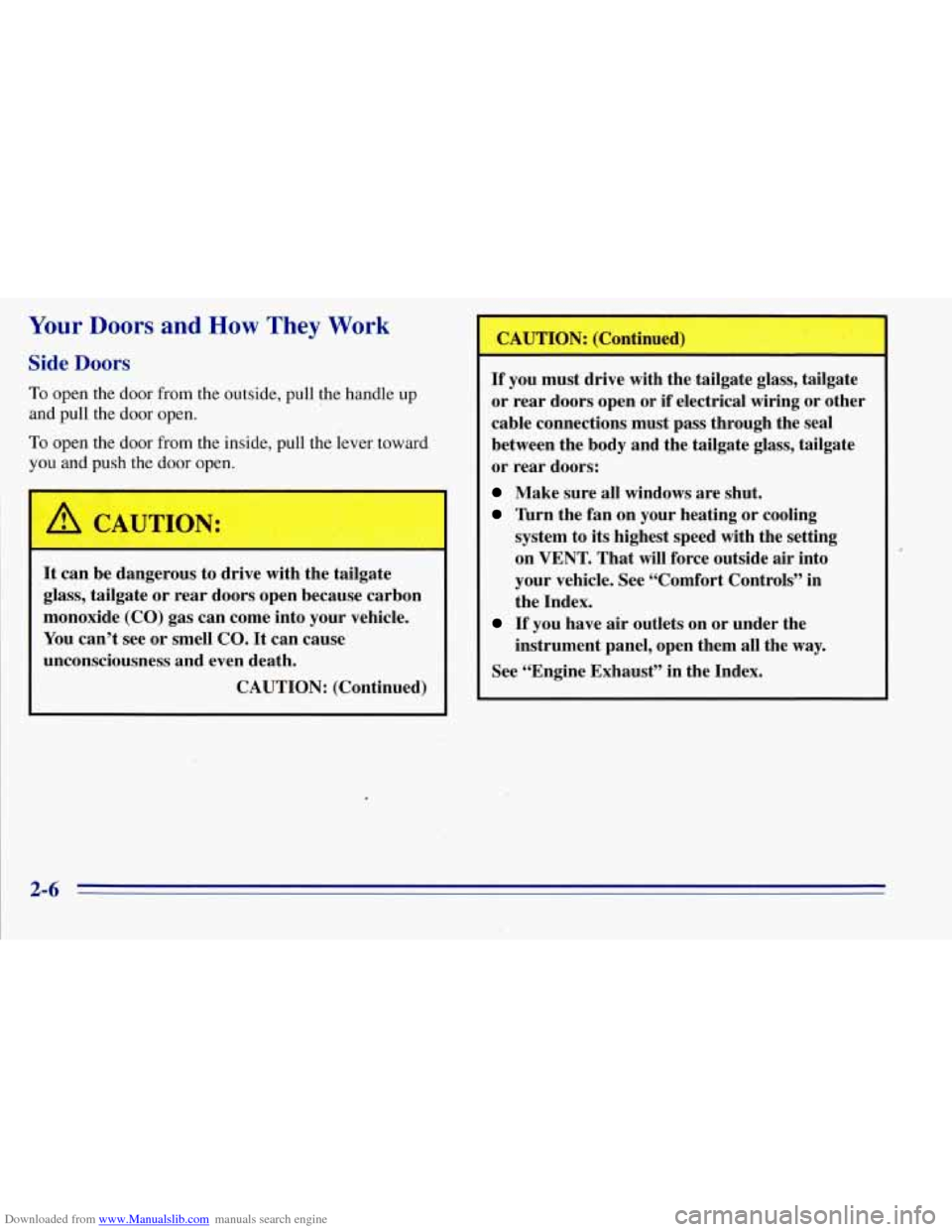
Downloaded from www.Manualslib.com manuals search engine Your Doors and How They Work
Side Doors
To open the door from the outside, pull the handle up
and pull the door open.
To open the door from the inside, pull the lever toward
you and push the door open.
1
It can be dangerous to drive with’the tailgate
glass, tailgate or rear doors open because carbon
monoxide (CO) gas can come into your vehicle.
You can’t see or smell CO.
It can cause
unconsciousness and even death.
CAUTION: (Continued) CAUTION: (Continued!
If you must drive with the tailgate glass, tailgate
or rear doors open or if electrical wiring or other
cable connections must pass through the.seal
between the body and the. tailgate glass, tailgate
or rear doors:
Make sure all windows are shut.
’hrn the fan on your heating or cooling
system to its highest speed with the setting
on VENT. That will force outside air into
your vehicle. See “Comfort Controls” in
the Index.
instrument panel, open them all the
way.
If you have air outlets on or under the
See “Engine Exhaust” in the Index.
2-6
Page 115 of 403
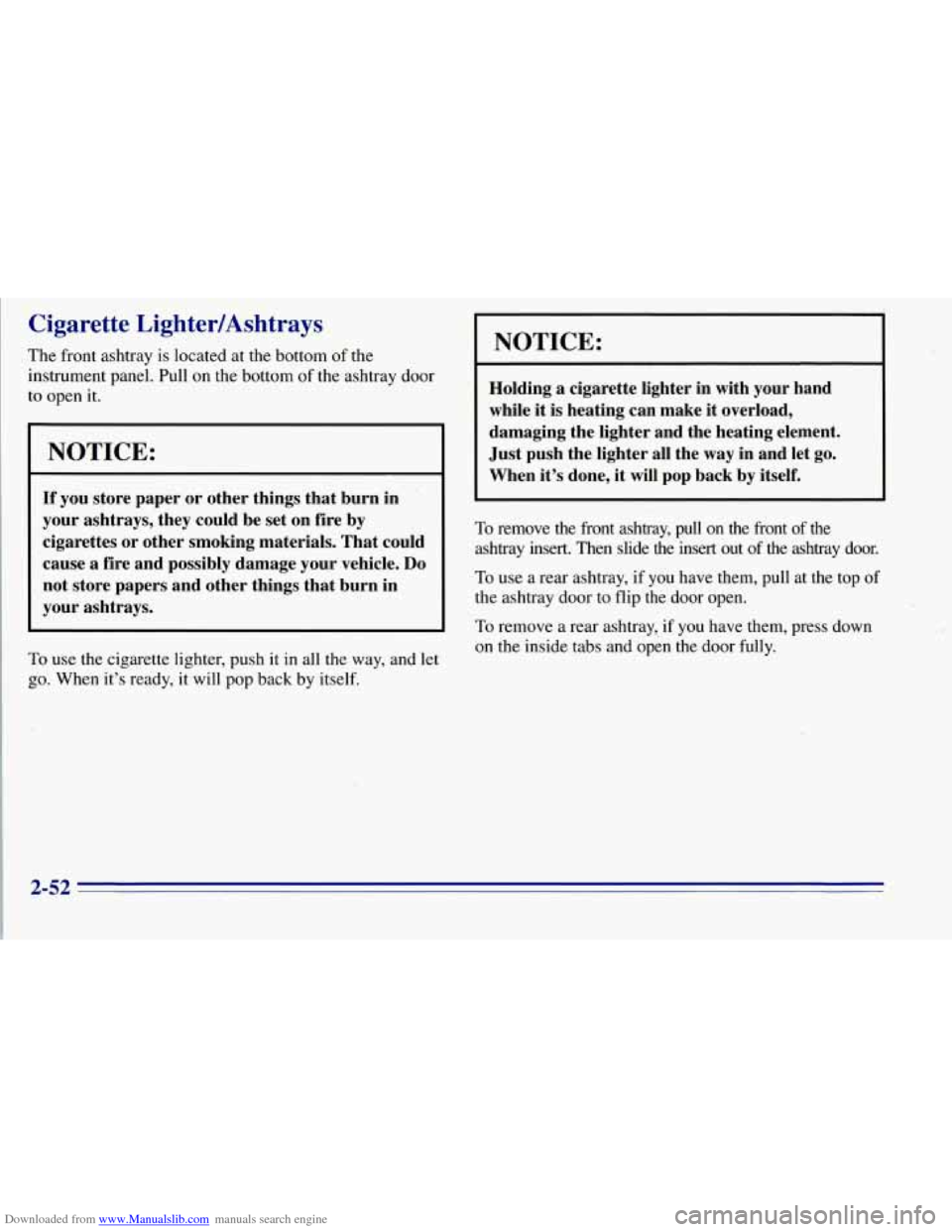
Downloaded from www.Manualslib.com manuals search engine Cigarette LightedAshtrays
The front ashtray is located at the bottom of the
instrument panel. Pull on the bottom
of the ashtray door
to open it.
NOTICE:
If you store paper or other things that burn in
your ashtrays, they could be
set on fire by
cigarettes or other smoking materials. That could
cause a fire and possibly damage your ‘vehicle.
Do
not store papers and other things that burn in
your ashtrays.
To use the cigarette lighter, push it in all the way, and let
go. When it’s ready, it will pop back by itself.
NOTICE:
Holding a cigarette lighter in with your hand
while
it is heating can make it overload,
damaging the lighter and the heating element.
Just push the lighter all the
way in and let go.
When it’s done,
it will pop back by itself.
To remove the front ashtray, pull on the front of the
ashtray insert. Then slide the insert out
of the ashtray door.
To use a rear ashtray, if you have them, pull at the top of
the ashtray door
to flip the door open.
To remove a rear ashtray, if you have them, press down
on the inside tabs and open the door fully.
2-52
Page 125 of 403

Downloaded from www.Manualslib.com manuals search engine Anti-Lock Brake System Warning Light
ANTI -
LOCK
With the anti-lock brake
system, this light will
come on when you start
your engine and may stay
on for several seconds.
That’s normal.
If the light stays on, or comes on when you’re driving,
your vehicle needs service. If the regular brake system
warning light isn’t
on, you still have brakes, but you
don’t have anti-lock brakes. If the regular brake system
warning light is also on, you don’t have anti-lock brakes
and there’s a problem with your regular brakes. See
“Brake System Warning Light” earlier in this part.
The anti-lock brake system warning light should come
on briefly when you turn the ignition key to RUN. If the
light doesn’t come
on then, have it fixed so it will be
ready to warn
you if there is a problem.
Engine Coolant Temperature Gage
This gage shows the engine
coolant temperature.
It also provides an indicator of how hard your vehicle is
working. During a majority of the operation the gage
will read 2
10 OF ( 100 ” C) or less. If you are pulling a
load or going up hills, it is normal for the temperature to
fluctuate and approach the 260”F( 160°C) mark. If the
gage. reaches the 260”F( 160°C) mark, it indicates that
the cooling system is working beyond its capacity.
In “Problems on the Road,” this manual shows what to
do. See “Engine Overheating” in the Index.
2-62
Page 132 of 403
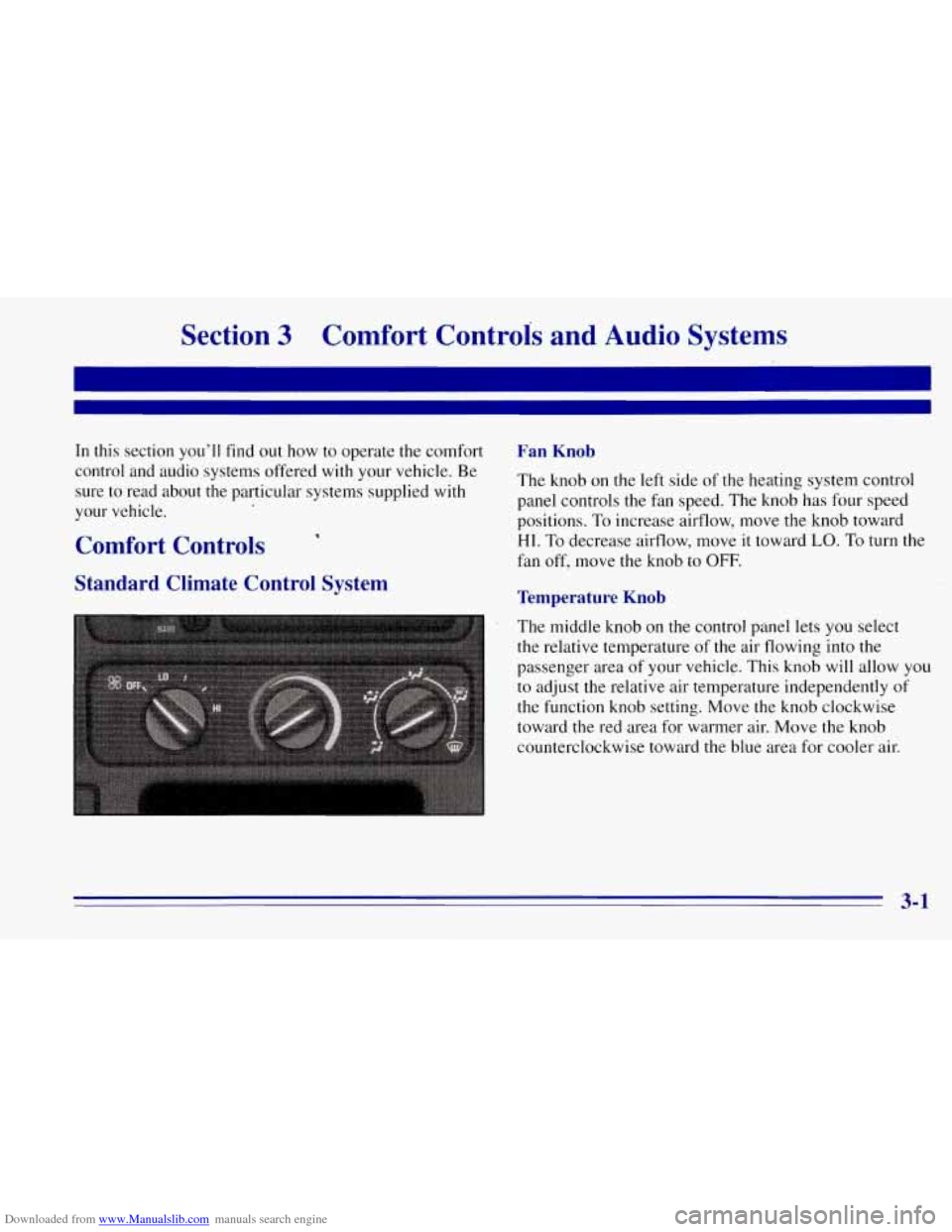
Downloaded from www.Manualslib.com manuals search engine Section 3 Comfort Controls and Audio Systems
In this section you’ll find out how to operate the comfort
control and audio systems offered with your vehicle. Be
sure to read about the particular systems supplied with
your vehicle. Fan Knob
The knob on the left side of the heating system control
panel controls the fan speed. The knob has four speed
positions. To increase airflow, move the knob toward
HI. To decrease airflow, move it toward LO. To turn the
fan off, move the knob to
OFF. Comfort Controls
Standard Climate Control System Temperature Knob
The middle knob on the control panel lets you select
the relative temperature of the air flowing into the
passenger area of your vehicle. This knob will allow
you
to adjust the relative air temperature independently of
the function knob setting. Move the knob clockwise
toward the red area for warmer air. Move the knob
counterclockwise toward the blue area for cooler air.
3-1
Page 133 of 403
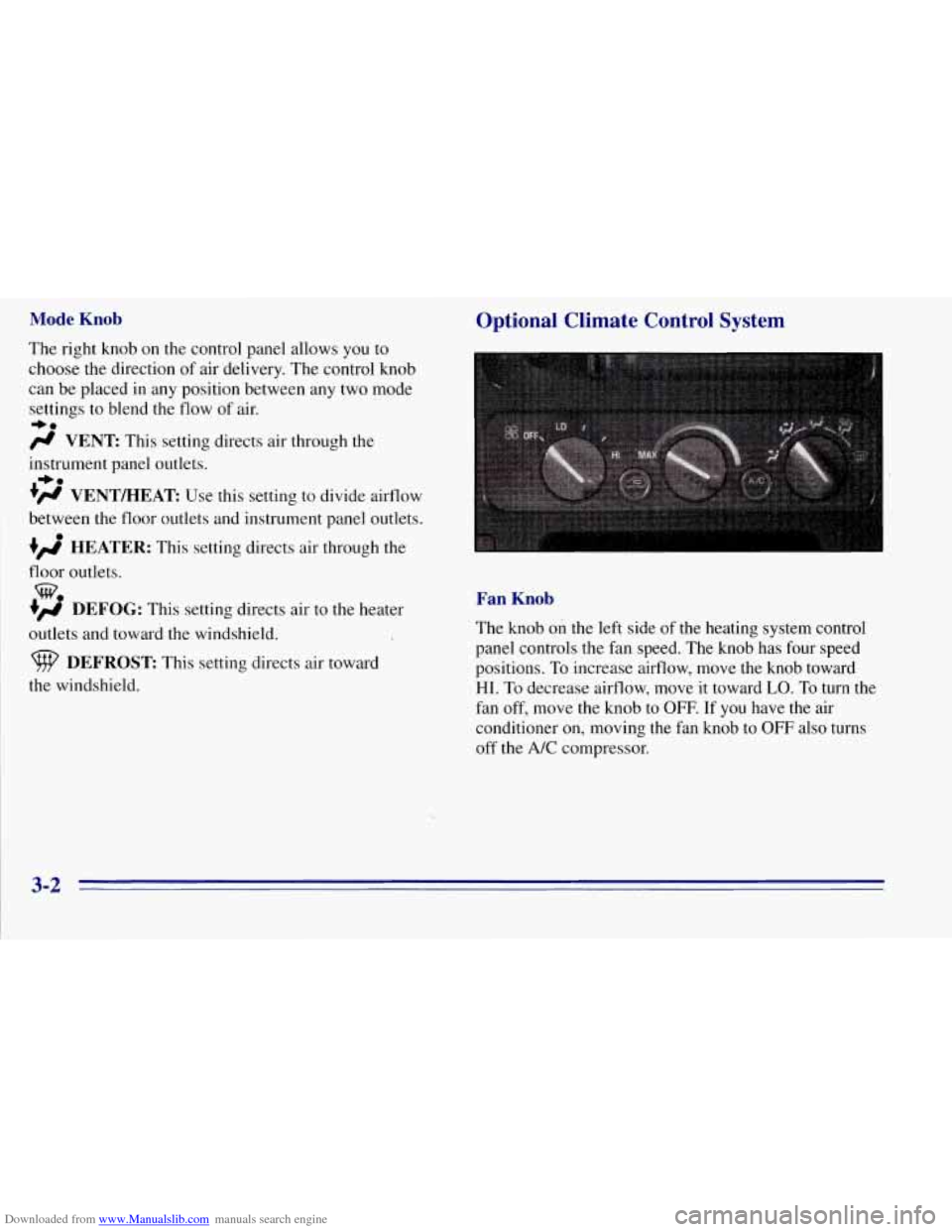
Downloaded from www.Manualslib.com manuals search engine Mode Knob
The right knob on the control panel allows you to
choose the direction
of air delivery. The control knob
can
be placed in any position between any two mode
settings to blend the flow of air.
+e
/J VENT This setting directs air through the
instrument panel outlets.
+’ VENT/HEAT Use this setting to divide airflow
between the floor outlets and instrument panel outlets.
+No HEATER: This setting directs air through the
floor outlets.
+fl DEFOG: This setting directs air to the heater
outlets and toward the windshield.
.+.
w.
DEFROST This setting directs air toward
the windshield.
Optional Climate Control System
Fan Knob
The knob on the left side of the heating system control
panel controls the fan speed. The
knob has four speed
positions. To increase airflow, move the knob toward
HI.
To decrease airflow, move it toward LO. To turn the
fan off, move the knob to
OFF. If you have the air
conditioner on, moving
the fan knob to OFF also turns
off the
A/C compressor.
3-2
Page 134 of 403

Downloaded from www.Manualslib.com manuals search engine Temperature Knob
The middle knob on the control pane-1 lets you select
the relative temperature of the air flowing into the
passenger area of your vehicle. This knob will allow you
to adj.ust the relative air temperature independently of
the function knob setting, Move the knob clockwise
toward the red area for warmer air. Move the knob
counterclockwise toward the blue area for cooler air.
Mode Knob
The right knob on the control panel allows you to
choose the direction of air delivery. The control knob
can be placed in any position between any two mode
settings to blend the flow of air.
+e
# VENT This setting directs air through the
instrument panel outlets.
+’ VENTMEAT Use this setting to divide airflow.
between the floor outlets and instrument panel outlets.
+e
HEATER: This setting directs air through the
floor outlets.
+# DEFOG: This setting directs air to the heater
outlets and toward the windshield.
9 DEFROST This setting directs air toward
the windshield.
w.
Rear Air Conditioning and Heating Systems
(Suburban)
’
If your vehicle has either or both of these systems, you
can increase and decrease the airflow at the rear vents.
Depending on the system
you have and the setting
selected,
you can send cooled or heated air to the rear of
the vehicle.
Rear Air Conditioning (Without Rear Heater)
If your vehicle has rear air conditioning (without rear
heater), the controls are located above the front and
second seats. The front and rear overhead controls let
you increase and decrease the airflow at the rear vents.
To operate the rear air conditioning system, the front air
conditioning system must be on. With the front air
conditioning system off, the rear system controls can be
used to circulate air in the rear of the vehicle.
3-3
Page 137 of 403

Downloaded from www.Manualslib.com manuals search engine To regulate the airflow location, adjust the center knob
on the control panel. Turn the knob clockwise for floor
vent airflow or counterclockwise for headliner vent
airflow. Generally, the upper vents are used for air
conditioning and the floor vents for heating. The control
knob can
be set to any blend setting.
To adjust the aifflow speed, turn the fan control knob
on the left side of the control panel to the desired
blower setting.
To activate the rear control, move the fan knob on the
front control
to REAR CNTL.
Air Conditioning
On hot days, open the windows long enough to let hot
air inside escape. This reduces the time it takes for your
vehicle to cool down. Then keep your windows closed
for the air conditioner to work its best.
The recirculation button, between the fan and temperature
knobs, allows the air inside your vehicle to be
recirculated. This setting helps to maximize your air
conditioner’s performance and your vehicle’s fuel
economy. This setting also cools the air the fastest and
can be used to keep unwanted odors and/or dust from
entering the vehicle. When using the air conditioner, turn
off recirculation after the vehicle reaches a comfortable
interior temperature. When the right knob on the control
panel is between HEATER and DEFROST, the
recirculation feature will not function.
The A/C button, between the temperature and mode
knobs, allows the air coming into your vehicle to be
cooled. This setting is useful for normal cooling on hot
days. When
you use A/C with the recirculation button
pushed in, turn off recirculation as soon as the vehicle
reaches a comfortable interior temperature.
The
rear control works just like the front control. It will
allow second seat passengers to adjust the controls as
they desire.
Page 138 of 403
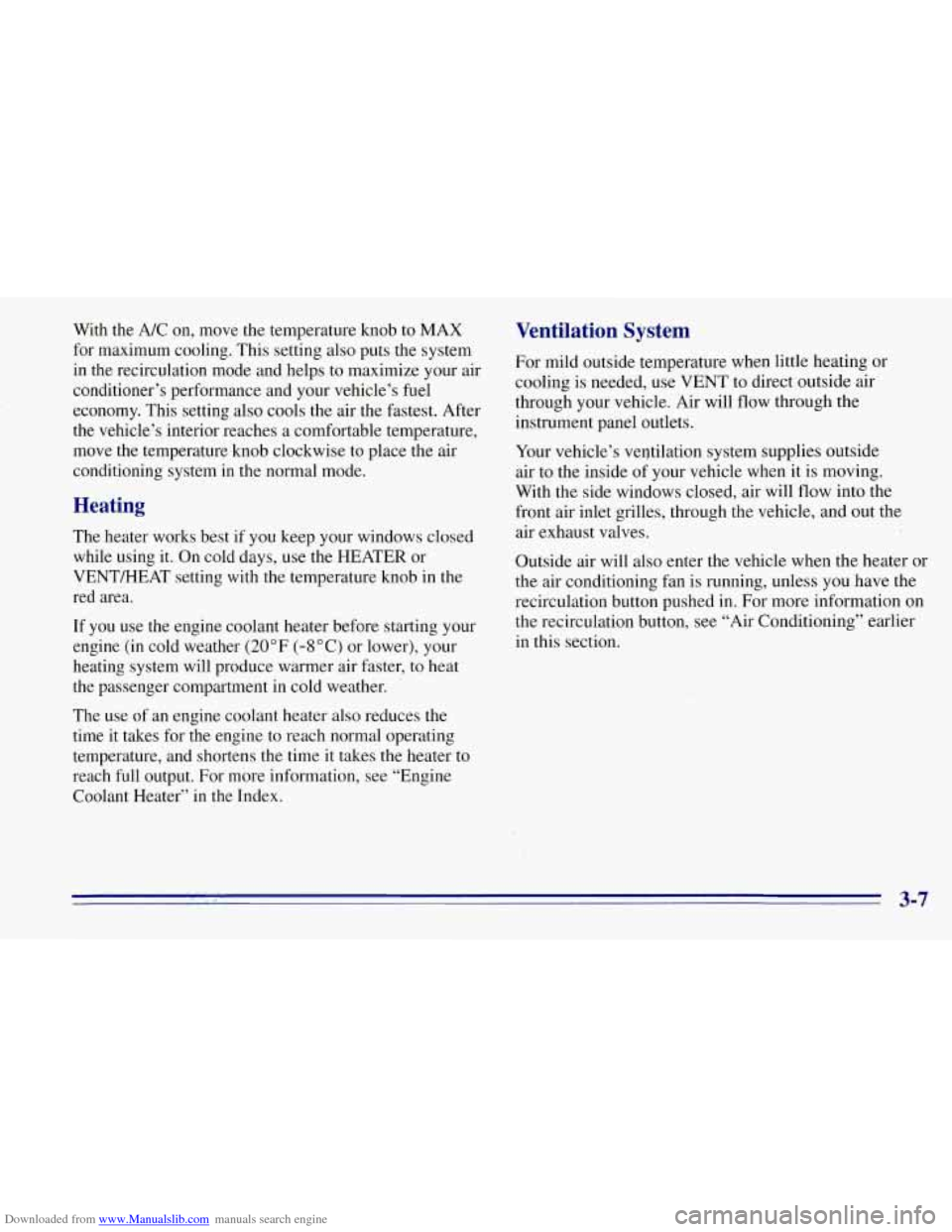
Downloaded from www.Manualslib.com manuals search engine With the A/C on, move the temperature knob to MAX
for maximum cooling. This setting also puts the system
in the recirculation mode and helps to maximize your air
conditioner’s performance and your vehicle’s fuel
economy. This setting also cools the air the fastest. After
the vehicle’s interior reaches a comfortable temperature,
move the temperature knob clockwise to place the air
conditioning system in the normal mode.
The heater works best if you keep your windows closed
while using it. On cold days, use the HEATER or
VENT/HEAT setting with the temperature knob in the
red area.
If you use the engine coolant heater before starting your
engine (in cold weather (20°F (-8OC) or lower), your
heating system will produce warmer air faster, to heat
the passenger compartment in cold weather.
The use of an engine coolant heater also reduces the
time it takes for the engine to reach normal operating
temperature, and shortens the time it takes the heater to
reach full output. For more information, see “Engine
Coolant Heater” in the Index. Ventilation System
For mild outside temperature when little heating or
cooling is needed, use VENT to direct outside air
through your vehicle. Air will flow through the
instrument panel outlets.
Your vehicle’s ventilation system supplies outside
air to the inside
of your vehicle when it is moving.
With the side windows closed, air will flow into the
front air inlet grilles, through the vehicle, and out the
air exhaust valves.
Outside air will also enter the vehicle when the heater or
the air conditioning fan is running, unless you have the
recirculation button pushed in. For more information
on
the recirculation button, see “Air Conditioning” earlier
in this section.
- .. G 3-7